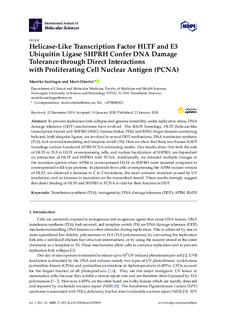| dc.contributor.author | Otterlei, Marit | |
| dc.contributor.author | Seelinger, Mareike | |
| dc.date.accessioned | 2020-02-18T12:13:14Z | |
| dc.date.available | 2020-02-18T12:13:14Z | |
| dc.date.created | 2020-02-17T10:54:48Z | |
| dc.date.issued | 2020 | |
| dc.identifier.citation | International Journal of Molecular Sciences. 2020, 21 (693), . | nb_NO |
| dc.identifier.issn | 1422-0067 | |
| dc.identifier.uri | http://hdl.handle.net/11250/2642272 | |
| dc.description.abstract | To prevent replication fork collapse and genome instability under replicative stress, DNA damage tolerance (DDT) mechanisms have evolved. The RAD5 homologs, HLTF (helicase-like transcription factor) and SHPRH (SNF2, histone-linker, PHD and RING finger domain-containing helicase), both ubiquitin ligases, are involved in several DDT mechanisms; DNA translesion synthesis (TLS), fork reversal/remodeling and template switch (TS). Here we show that these two human RAD5 homologs contain functional APIM PCNA interacting motifs. Our results show that both the role of HLTF in TLS in HLTF overexpressing cells, and nuclear localization of SHPRH, are dependent on interaction of HLTF and SHPRH with PCNA. Additionally, we detected multiple changes in the mutation spectra when APIM in overexpressed HLTF or SHPRH were mutated compared to overexpressed wild type proteins. In plasmids from cells overexpressing the APIM mutant version of HLTF, we observed a decrease in C to T transitions, the most common mutation caused by UV irradiation, and an increase in mutations on the transcribed strand. These results strongly suggest that direct binding of HLTF and SHPRH to PCNA is vital for their function in DDT. | nb_NO |
| dc.language.iso | eng | nb_NO |
| dc.publisher | MDPI | nb_NO |
| dc.rights | Navngivelse 4.0 Internasjonal | * |
| dc.rights.uri | http://creativecommons.org/licenses/by/4.0/deed.no | * |
| dc.title | Helicase-Like Transcription Factor HLTF and E3 Ubiquitin Ligase SHPRH Confer DNA Damage Tolerance through Direct Interactions with Proliferating Cell Nuclear Antigen (PCNA) | nb_NO |
| dc.type | Journal article | nb_NO |
| dc.type | Peer reviewed | nb_NO |
| dc.description.version | publishedVersion | nb_NO |
| dc.source.pagenumber | 14 | nb_NO |
| dc.source.volume | 21 | nb_NO |
| dc.source.journal | International Journal of Molecular Sciences | nb_NO |
| dc.source.issue | 693 | nb_NO |
| dc.identifier.doi | 10.3390/ijms21030693 | |
| dc.identifier.cristin | 1794619 | |
| dc.description.localcode | This is an open access article distributed under the Creative Commons Attribution License which permits unrestricted use, distribution, and reproduction in any medium, provided the original work is properly cited. | nb_NO |
| cristin.unitcode | 194,65,15,0 | |
| cristin.unitname | Institutt for klinisk og molekylær medisin | |
| cristin.ispublished | true | |
| cristin.fulltext | original | |
| cristin.qualitycode | 1 | |

